Developer Guide
SalesNote is a desktop app for tailors, optimized for use via a Command Line Interface (CLI), suitable for fast typists. SalesNote aims to help tailors simplify their administrative tasks, with the main features split between helping to manage:
- Client information (e.g. contact details, measurements, notes)
- Tasks to be done
- Sales orders and accounts
The purpose of the Developer Guide is to guide you through our application’s architecture, so you are familiar with the underlying structure.
Table of Contents
- Acknowledgements
- Setting up, getting started
- Design
- Implementation
- Documentation, logging, testing, configuration, dev-ops
- Appendix: Requirements
- Appendix: Instructions for manual testing
Acknowledgements
- This project is based on the AB3 project created by the SE-EDU initiative.
- Application logo - Copyright by yupiramos
- Adapted code -
formatTotalColumnandsetCloseOnEsc
Setting up, getting started
Refer to the guide Setting up and getting started.
Design
.puml files used to create diagrams in this document can be found in the diagrams folder. Refer to the PlantUML Tutorial at se-edu/guides to learn how to create and edit diagrams.
Architecture

The Architecture Diagram given above explains the high-level design of the App.
Given below is a quick overview of main components and how they interact with each other.
Main components of the architecture
Main has two classes called Main and MainApp. It is responsible for,
- At app launch: Initializes the components in the correct sequence, and connects them up with each other.
- At shut down: Shuts down the components and invokes cleanup methods where necessary.
Commons represents a collection of classes used by multiple other components.
The rest of the App consists of four components.
-
UI: The UI of the App. -
Logic: The command executor. -
Model: Holds the data of the App in memory. -
Storage: Reads data from, and writes data to, the hard disk.
How the architecture components interact with each other
The Sequence Diagram below shows how the components interact with each other for the scenario where the user issues the command deletetask 1.

Each of the four main components (also shown in the diagram above),
- defines its API in an
interfacewith the same name as the component. - implements its functionality using a concrete
{Component Name}Managerclass (which follows the corresponding APIinterfacementioned in the previous point.
For example, the Logic component defines its API in the Logic.java interface and implements its functionality using the LogicManager.java class which follows the Logic interface. Other components interact with a given component through its interface rather than the concrete class (reason: to prevent outside component’s being coupled to the implementation of a component), as illustrated in the (partial) class diagram below.

The sections below give more details of each component.
UI component
The API of this component is specified in Ui.java

The UI consists of a MainWindow that is made up of parts e.g.CommandBox, ResultDisplay, PersonListPanel, StatusBarFooter etc. All these, including the MainWindow, inherit from the abstract UiPart class which captures the commonalities between classes that represent parts of the visible GUI.
The UI component uses the JavaFx UI framework. The layout of these UI parts are defined in matching .fxml files that are in the src/main/resources/view folder. For example, the layout of the MainWindow is specified in MainWindow.fxml
The UI component,
- executes user commands using the
Logiccomponent. - listens for changes to
Modeldata so that the UI can be updated with the modified data. - keeps a reference to the
Logiccomponent, because theUIrelies on theLogicto execute commands. - depends on some classes in the
Modelcomponent, as it displaysPerson,TaskandOrderobjects residing in theModel.
Logic component
API : Logic.java
Here’s a (partial) class diagram of the Logic component:

How the Logic component works:
- When
Logicis called upon to execute a command, it uses theSalesNoteParserclass to parse the user command. - This results in a
Commandobject (more precisely, an object of one of its subclasses e.g.,AddCommand) which is executed by theLogicManager. - The command can communicate with the
Modelwhen it is executed (e.g. to add a client). - The result of the command execution is encapsulated as a
CommandResultobject which is returned back fromLogic.
The Sequence Diagram below illustrates the interactions within the Logic component for the execute("deletetask 1") API call.

DeleteTaskCommandParser should end at the destroy marker (X) but due to a limitation of PlantUML, the lifeline reaches the end of diagram.
Here are the other classes in Logic (omitted from the class diagram above) that are used for parsing a user command:

How the parsing works:
- When called upon to parse a user command, the
SalesNoteParserclass creates anXYZCommandParser(XYZis a placeholder for the specific command name e.g.,AddCommandParser) which uses the other classes shown above to parse the user command and create aXYZCommandobject (e.g.,AddCommand) which theSalesNoteParserreturns back as aCommandobject. - All
XYZCommandParserclasses (e.g.,AddCommandParser,DeleteCommandParser, …) inherit from theParserinterface so that they can be treated similarly where possible e.g, during testing.
Model component
API : Model.java
Here are class diagrams for the important components in the Model package. This first image shows the relations between the important classes in the package:

Class Diagram of the Person’s entity:

Class Diagram of the Task’s entity:
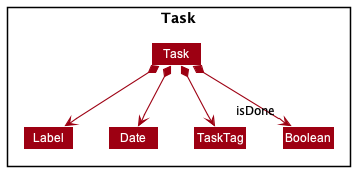
Class Diagram of the Order’s entity:

The Model component,
- stores these three types of data in SalesNote
- Address book data i.e., all
Personobjects (which are contained in aUniquePersonListobject). - Task book data i.e., all
Taskobjects (which are contained in aUniqueTaskListobject). - Order book data i.e., all
Orderobjects (which are contained in aUniqueOrderListobject).
- Address book data i.e., all
- stores the currently ‘selected’
Person,Task, andOrderobjects (e.g., results of a search query) as separate filtered lists which are exposed to outsiders as unmodifiableObservableList<Person>,ObservableList<Task>andObservableList<Order>respectively that can be ‘observed’ e.g. the UI can be bound to these lists so that the UI automatically updates when the data in the lists change. - stores a
UserPrefobject that represents the user’s preferences. This is exposed to the outside as aReadOnlyUserPrefobjects. - does not depend on any of the other three components (as the
Modelrepresents data entities of the domain, they should make sense on their own without depending on other components).
Storage component
API : Storage.java

How the Storage component works:
- Saves address book, task book, sales order book and user preference data in json format, and read them back into corresponding objects.
- The main storage class inherits from all of
AddressBookStorage,TaskBookStorage,OrderBookStorage, andUserPrefStorage, which means it can be treated as either one (if only the functionality of only one is needed). - Each book storage (
AddressBookStorage,TaskBookStorage,OrderBookStorage) has aJsonSerializableclass which is in charge of converting the model’s data into correct json file and retrieving the data from the json file to convert it to a model data. - Each
JsonSerializableclass implements its ownJsonAdaptedclass which specifies methods to convert model object (i.ePerson,Task,Order) into json object and vise versa. - The
JsonSerializableclass andJsonAdaptedclass also checks the correctness of the json files format, and in the case when any of the format is wrong, it will then throw aDataConversionExceptionandIllegalValueException.
Common classes
Classes used by multiple components are in the seedu.address.commons package.
Implementation
This section describes some noteworthy details on how certain features are implemented.
Task and order package
The implementation of both of these packages is largely similar to the Person package. In the original AB3, there is a
Person class, stored in a UniquePersonList that handles list operations, further stored in a AddressBook that handled
other utility functions like data management.
Following this structure and outline, we had a Task class, stored in a UniqueTaskList stored in a TaskBook, and an
Order class, stored in a UniqueOrderList stored in an OrderBook. The updated model diagram reflecting these
changes can be seen in the Model component.
Similar to the Person class, the Task and Order classes have fields, as seen here:


These fields satisfy the following conditions:
- Both:
-
Date,Label: Nonempty block of alphanumeric characters of length at most 100 characters. We felt this was a reasonable length for both fields, and would guarantee the UI display works the way we intended.
-
- Task:
-
TaskTag: This is a tag that is eitherGeneral, orSO{ID}whereIDis theIdfield of someOrderobject. -
isDone: Boolean flag to indicate whether or not the task is done.
-
- Order:
-
Amount: Accepts any string that can be parsed by Double.parseDouble(), that results in a non-negative real number. Represents the amount the user charges for a givenOrder -
Customer: Blocks of 1 or more alphanumeric characters, separated by at most one space. Represents thePersonthe order is addressed to. -
id: Long used to uniquely identifyOrderobjects. In this case, we did not deal with potential overflow given that the range of a Long in Java is up to 2^63 (which is > 10^18!). We judged that this should be more than sufficient for any realistic use of the application. -
isComplete: Boolean flag to indicate when theOrderis complete, and payment has been received.
-
Something alluded to in the fields above, is that there are implicit dependencies between the Task, Order, and Person classes.
To add an Order to SalesNote, we decided it made the most sense for there to already be a Person in the application
the Order was addressed to. So for instance, to add an order from a client named Jamie Tan, the user would need to ensure
that a Person with Name Jamie Tan existed in the application first.
Another link we thought would make sense to allow for, was to make it possible to tie an Order object to related Task objects.
Task objects were meant to help users manage their work, and so we felt there should be a way for a user to relate a Task
to a specific Order if they wanted to.
In both of these cases, we did not link the classes directly, hence there is no arrow between the Order and Person class
and no arrow between the Order and Task class in the diagram above. Instead, we simply made use of the fact that SalesNote
maintains both a UniquePersonList and a UniqueOrderList. To relate an Order to a Person, it is enough to remember the
Name field (in UniquePersonList, two Person objects with the same Name are considered equal). To relate a Task to
an Order, we can make use of the fact that Order objects have unique id fields.
Design choices
A very reasonable alternative one might consider is linking the classes directly. For instance, allowing a Person, to
have a list of Order objects related to the Person, and an Order, to have a list of Task objects related to the Order.
This was an alternative method we considered, that would come with a cost in complexity by relating the Person,
Task and Order objects. We felt that the method we chose that made use of the UniqueXList properties and kept the
classes more distinct better adhered to the Separation of Concerns Principle.
Updating related fields in Person class
In implementing the fields for the Task and Order object and considering possible feature flaws, we decided to update
the fields for the Person class as well. The original AB3 treated two people as equal only if their names were spelt exactly
the same, with this being case-sensitive. We decided that multiple clients having the exact same name was rare
enough that this notion of equality made sense, however, we felt it should apply regardless of case, i.e. a Person with Name john doe
should be recognised as the same a Person with Name JOHN DOE.
We updated the equality check to account for this, and also updated the input validation for Name to allow at most one
space between blocks of characters (previously John Doe would be different from John Doe. We felt this likely to be
a mistake and should be avoided).
Adding order feature
As mentioned above, to add an Order, the Person the Order is addressed to should already be in SalesNote. The
following is a sequence diagram showing the execution of the command:
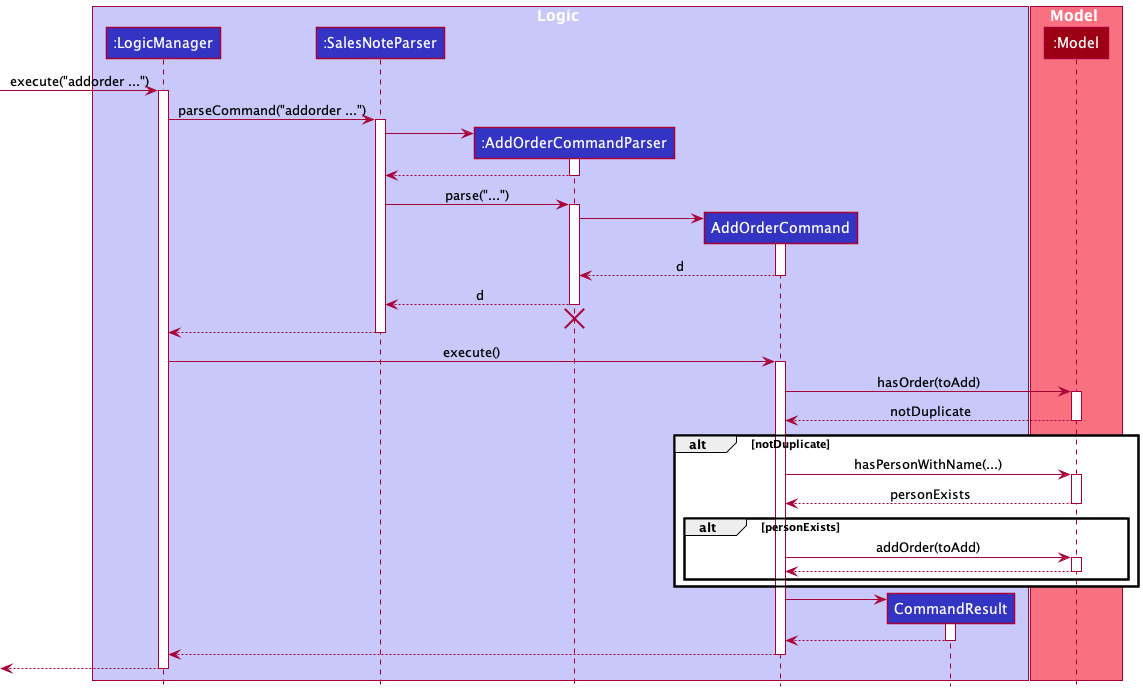
Focusing on after AddOrderCommand:execute is called,
- First the application calls
model:hasOrder(toAdd)to check iftoAddis already in the model. - Next, the application calls
model:hasPersonWithName(toAdd.getCustomer.getName())to check if thePersontheOrderis addressed to is already in the application - If both checks pass, the application finally calls
model:addOrder(toAdd)to add theOrder.
Note that in the diagram above, the “else” clause for the alt boxes have been omitted for brevity. If either check fails,
an exception is thrown and an error is displayed back to the user.
Here is an activity diagram to more clearly illustrate the logic of the application:
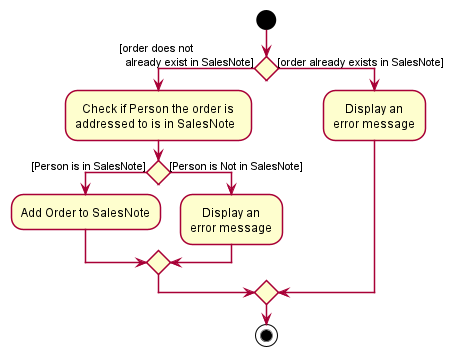
Result
An Order can only be added to SalesNote if the Person it is addressed to is already in SalesNote, and the Order
is unique and does not duplicate an existing Order object in SalesNote.
Updating person changes in order list and task list
Other commands where the relationships between the Order, Person and Task classes comes up is in
editing and deletion of clients. We wanted to achieve the following:
- When a client is deleted, their orders and the tasks linked to the orders will be deleted as well.
- When a client name is modified, this change will be updated in their existing orders.
Execution
The sequence diagram below shows the interaction between the Logic and Model components when a DeleteCommand is executed.

-
DeleteCommand::executeis called and deletes the client from the list. - Related orders are obtained by matching the client’s name and the customer of the existing orders.
- Tasks linked to the orders and the orders themselves are deleted.
The sequence diagram below shows the interaction between the Logic and Model components when a EditCommand is executed.
![Interactions Inside the Logic Component for the `edit 1 n/[new name]` command](/tp/images/EditSequenceDiagram.png)
-
EditCommand::executeis called and the client’s details are modified. - Related orders are obtained by matching the client’s old name and the customer of the existing orders.
- The related orders’ customer’s name are updated.
Result
The changes in person objects are updated in their order and task objects.
Other related commands
Note that similar considerations are addressed in the following commands:
-
DeleteOrderCommandwhereTaskobjects related to the deletedOrderis also deleted. -
AddTaskCommandandEditTaskCommandwhere if the user attempts to tag aTaskto aOrder, SalesNote first checks if theOrderalready exists.
We have omitted these as their implementation concerns are largely similar to the two above that we have already presented.
Sorting orders feature
By default, orders are sorted in ascending order of their id.
This arrangement is also followed when SalesNote starts up or the listorders command is executed.
The sortorders command sorts the orders in the OrderBook based on a field and an ordering specified by the user.
The field is represented using the SortFieldType enumeration which is encapsulated as a SortField object.
Currently, SalesNote supports sorting by the following fields, which have been adapted to implement the Comparable interface:
-
Amount- Represented bySortFieldType.AMOUNT -
Date- Represented bySortFieldType.DATE
The ordering is represented using the SortOrderingType enumeration which is encapsulated as a SortOrderingType object. SalesNote supports sorting in:
- Ascending order - Represented by
SortOrderingType.ASCENDING - Descending order - Represented by
SortOrderingType.DESCENDING
The class structure of the feature is shown in the diagram below:
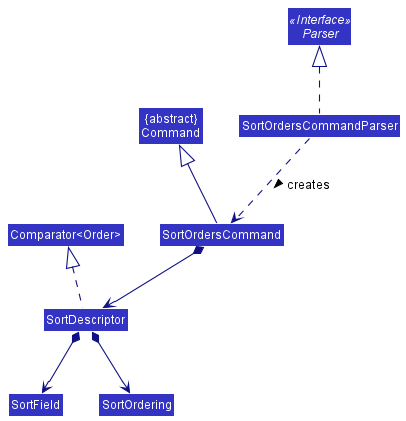
Orders are sorted using the SortDescriptor, which implements the Comparator<Order> interface.
Its compare method uses the SortField and SortOrdering to compare orders based on the user specified arrangement.
Execution
The Sequence Diagram below illustrates the interactions within the Logic component for the parseCommand("sortorder f/a o/asc") API call.
Details about tokenizing the user input to retrieve the field and ordering have been omitted.
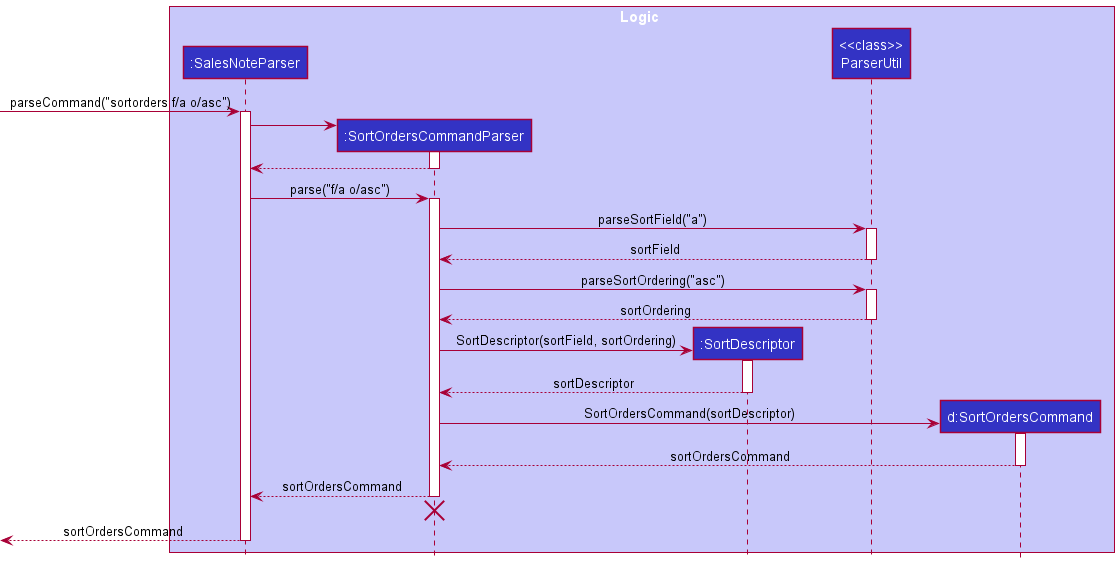
SortOrdersCommandParser should end at the destroy marker (X) but due to a limitation of PlantUML, the lifeline reaches the end of diagram.
When the SortOrderCommand is executed, the following interactions take place in the Logic and the Model components.
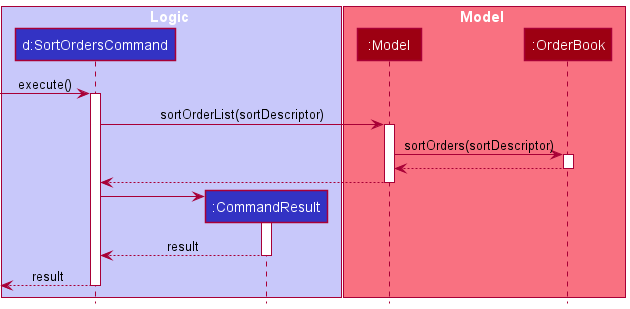
After the OrderBook has been sorted by the amount field in ascending order,
- The
SortCommandobtains the relevant success message by invokingsortDescriptor.generateSuccessMessage(). - A
CommandResultobject is then instantiated using the message, and returned toLogicManager. - The UI proceeds to display the sorted list of orders.
Design choices
-
Alternative 1 (current choice): Mutating the
OrderList.- Pros: Allows the sorting functionality to be less coupled with the
FilteredListof orders.- This allows the user the flexibility to combine various filtering and sorting commands.
- For instance, executing
incompleteordersfollowed bysortorders f/d o/descwould list the incomplete orders sorted by their date in descending order.
- Cons: Commands that mutate the list might disrupt the ordering of the sorted list.
- For instance, adding an
Orderto anOrderBooksimply appends it at the end of theOrderList. Thus, theOrderBookneeds to be reverted to its default arrangement by callingModelManager.resetOrderView()whenever an order is added. - Note that this is not a concern for the
markorderanddeleteordercommands since they do not disrupt the ordering of the list.
- For instance, adding an
- Pros: Allows the sorting functionality to be less coupled with the
-
Alternative 2: Wrapping the
FilteredListaround theSortedList.- Pros:
- Maintains the immutability of the order list.
- Ensures that the sorting arrangement is always preserved, even when another command e.g.
addordermutates the underlying list.
- Cons: More difficult to implement since it entails more coupling with the
FilteredListof orders.
- Pros:
Displaying clients’ total orders feature
The feature displays the total orders for all clients except those without orders in a new window.
Its mechanism is a mix of the mechanisms for MainWindow and HelpWindow.
Similar to help and exit, CommandResult has a dedicated boolean field to indicate whether the command is a
totalorders command. There is also a dedicated method to handle totalorders command in MainWindow class.
By calling this method, the data of total orders is reloaded similar to loading other data (Client/Task/Order) in the Main Window, i.e.
through the Logic component. After reloading data, that method shows or focuses the total orders window similar to that of the
help window.
Execution
The sequence diagram below shows the interaction within the UI component when a totalorders command is executed.
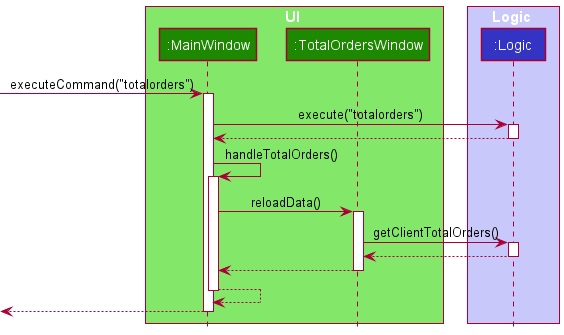
The sequence diagram below shows the interaction within the Logic component when the UI component calls
execute("totalorders"). Note that there is no need to have a TotalOrdersCommandParser. This is because the
SalesNoteParser can directly create and return a TotalOrdersCommand, similar to that of help and exit commands.

Documentation, logging, testing, configuration, dev-ops
Appendix: Requirements
Product scope
Target user profile:
- has a need to manage a significant number of clients
- prefer desktop apps over other types
- can type fast
- prefers typing to mouse interactions
- is reasonably comfortable using CLI apps
- needs help managing tasks
- needs help keeping financial record of sales
Value proposition:
Lightweight application that helps manage contacts faster than a typical mouse/GUI driven app,
and provides simple but helpful features to assist with managing a business.
User stories
Priorities: High (must have) - * * *, Medium (nice to have) - * *, Low (unlikely to have) - *
| Priority | As a … | I want to … | So that I can… |
|---|---|---|---|
* * * |
user | add a deadline to a sales order | I can keep track of when I must complete it by |
* * * |
user | keep track of the contact details of my clients | it is easier to find their contact details |
* * * |
user | maintain the preferences and body dimensions of my clients | I can cater to their requirements |
* * * |
user | mark tasks as done | |
* * * |
user | key customer orders into the application | I know what I need to complete |
* * * |
user | delete a task | get rid of task no longer needed to track |
* * * |
user | know the valid commands when I key in the wrong command | to help me remember what I should do |
* * * |
new user | categorise my customers, to group them by categories relevant to me | I can find the group of customers that I want easily |
* * * |
non-tech-savvy user | add users in a simple and straightforward way | I can get up to speed easily |
* * * |
user | easily update contact details as these are likely to change over time. | I can get up to speed easily |
* * * |
forgetful user | have reminders about deadlines | I am on track with my work |
* * * |
user | know how much in total sales each of my customers has brought in for me | |
* * |
user | track how much money I’m making each month | I can plan my budget accordingly |
* * |
experienced user | clear past entries | the application is less cluttered |
* * |
user | sort my deadlines by date | I can keep track of which are the most urgent. |
* * |
user | add notes to tasks | I can add details about special requests or notes for myself, for tasks that might be more difficult and/or take up more time |
* * |
user | update the requirements of my clients as their needs and preferences change | I am aware of their latest preference |
* * |
new user | have a tutorial to guide my on how to use the product | I can get myself started |
* * |
user with poor eyesight | the text in the interface to be easily readable | |
* * |
experienced user | the application to be fast and easy | |
* * |
user | keep track of the sales | I don’t have to remember them |
* |
user | keep track of outstanding payments | |
* |
user | know the breakdown of my sales each month | to understand better which of my products are more popular |
* |
user | backup/undo my actions | I can recover my lost data easily |
* |
experienced user | sort my clients by how much in sales they have brought in for me | I can focus more on clients that brings me more profit |
* |
skilled user | define my own shortcuts for commands | |
* |
user who is picky about UI | redesign aspects of the application. | |
* |
user | know how much I spent on materials | I don’t exceed my budget |
* |
secure my data/information | secure my data/information | |
* |
experienced user | use the app to track my material usage | I know when to order more in advance |
Use cases
For the use cases that are very similar, only the differences between them have been highlighted.
(For all use cases below, the System is the SalesNote and the Actor is the user, unless specified otherwise)
Use case: Add a client
MSS
- User requests to add a specific client to the client list.
-
SalesNote adds the client to the list.
Use case ends.
Extensions
-
1a. The format / details of the request are invalid.
- 1a1. SalesNote shows an error message.
- 1a2. User enters a new request.
-
Steps 1a1-1a2 are repeated until the request is valid.
Use case resumes from step 2.
-
2a. The client already exists in the client list
-
2a1. SalesNote shows an error message
Use case resumes from step 1.
-
Use case: Add a task
Analogous to the use case for adding a client.
Additional Extensions
-
2b. The tag specified for the task does not correspond to an existing sales order.
-
2b1. SalesNote shows an error message.
Use case resumes from step 1.
-
Use case: Add an order
Analogous to the use case for adding a client.
Additional Extensions
-
2b. The customer specified for the order does not correspond to an existing client.
-
2b1. SalesNote shows an error message.
Use case resumes from step 1.
-
Use case: Delete a client
MSS
- User requests to list clients.
- SalesNote shows a list of clients.
- User requests to delete a specific client in the list.
- SalesNote deletes the client.
- SalesNote deletes the orders related to that client.
-
SalesNote deletes the tasks related to those orders.
Use case ends.
Extensions
-
2a. The list is empty.
Use case ends.
-
3a. The given index is invalid.
-
3a1. SalesNote shows an error message.
Use case resumes at step 2.
-
-
5a. No related orders found.
Use case ends.
-
6a. No related tasks found.
Use case ends.
Use case: Delete a task
MSS
- User requests to list tasks.
- SalesNote shows a list of tasks.
- User requests to delete a specific task in the list.
-
SalesNote deletes the task.
Use case ends.
Extensions
-
2a. The list is empty.
Use case ends.
-
3a. The given index is invalid.
-
3a1. SalesNote shows an error message.
Use case resumes at step 2.
-
Use case: Delete an order
MSS
- User requests to list orders.
- SalesNote shows a list of orders.
- User requests to delete a specific order in the list.
- SalesNote deletes the order.
-
SalesNote deletes the tasks related to the order.
Use case ends.
Extensions
-
2a. The list is empty.
Use case ends.
-
3a. The given index is invalid.
-
3a1. SalesNote shows an error message.
Use case resumes at step 2.
-
-
5a. No related tasks found.
Use case ends.
Use case: Edit a task
MSS
- User requests to list tasks.
- SalesNote shows a list of tasks.
- User requests to edit the details of a specific task in the list.
-
SalesNote edits the details of the task.
Use case ends.
Extensions
-
2a. The list is empty.
Use case ends.
-
3a. The format / details of the request are invalid.
- 3a1. SalesNote shows an error message.
- 3a2. User enters a new request.
-
Steps 3a1-3a2 are repeated until the request is valid.
Use case resumes from step 4.
-
4a. The user has not made any changes to the task details.
Use case resumes at step 3.
-
4b. A task with the edited details already exists in the task list.
-
2b1. SalesNote shows an error message.
Use case resumes from step 3.
-
Use case: Edit a client
Analogous to the use case for editing a task.
Additional Extensions
-
4c. The user edits the name of the client.
-
4d1. SalesNote updates all orders linked to the client with the new client name.
Use case ends.
-
-
4d. The user updates the gender of a client without updating their dimensions.
-
4d1. SalesNote shows an error message.
Use case resumes from step 3.
-
Use case: Find a client
MSS
- User requests to find clients by a given keyword.
-
SalesNote shows a list of clients whose details match at least 1 keyword.
Use case ends.
Extensions
-
2a. None of the clients match the keyword.
-
2a1. SalesNote displays an empty client list.
Use case ends.
-
Use case: Find a task
Analogous to the use case for finding a client.
Use case: Find an order
Analogous to the use case for finding a client.
Use case: Mark a task as done
MSS
- User requests to list incomplete tasks.
- SalesNote shows a list of incomplete tasks.
- User requests to mark a specific task in the list as done.
-
SalesNote marks the task as done.
Use case ends.
Extensions
-
2a. The list is empty.
Use case ends.
-
3a. The given index is invalid.
-
3a1. SalesNote shows an error message.
Use case resumes at step 2.
-
Use case: Mark an order as complete
Analogous to the use case for marking a task as done.
Use case: Sort orders
MSS
- User requests to list orders.
- SalesNote shows a list of orders.
- User requests to sort the orders by a specified field in either ascending or descending order.
-
SalesNote displays the sorted list of orders.
Use case ends.
Extension
-
2a. The list is empty.
Use case ends.
-
3a. The format / details of the request are invalid
- 3a1. SalesNote shows an error message.
- 3a2. User enters a new request.
-
Steps 3a1-3a2 are repeated until the request is valid.
Use case resumes from step 3.
Non-functional requirements
- Should work on any mainstream OS as long as it has Java
11or above installed. - Should be able to hold up to 1000 clients without a noticeable sluggishness in performance for typical usage.
- A user with above average typing speed for regular English text (i.e. not code, not system admin commands) should be able to accomplish most of the tasks faster using commands than using the mouse.
- Currency amounts, dates, and times should follow Singapore standards.
Glossary
- Mainstream OS: Windows, Linux, Unix, OS-X
- Client: A customer in the database, identified by their name.
- Order: A sales order from a customer scheduled for a target date.
- Task: A task for the user that has a due date and a completion status.
-
Tag: A short string descriptor attached to a
PersonorTaskobject.
Appendix: Instructions for manual testing
Given below are instructions to test the app manually.
Launch and shutdown
-
Initial launch
-
Download the jar file and copy into an empty folder.
-
Double-click the jar file.
Expected: Shows the GUI with sample clients, tasks and orders. The window size may not be optimum.
-
-
Saving window preferences
-
Resize the window to an optimum size. Move the window to a different location. Close the window.
-
Re-launch the app by double-clicking the jar file.
Expected: The most recent window size and location is retained.
-
-
Shutdown
- Shut down the app using the
exitcommand.
Expected: The app shuts down.
- Shut down the app using the
Deleting a client
-
Deleting a client while all clients are being shown
-
Prerequisites: List all clients using the
listclientscommand. Multiple clients in the list. -
Test case:
deleteclient 1
Expected: First client is deleted from the list. Details of the deleted client shown in the status message. -
Test case:
deleteclient 0
Expected: No client is deleted. Error details shown in the status message. Status bar remains the same. -
Other incorrect delete client commands to try:
deleteclient,deleteclient x,...(where x is larger than the list size)
Expected: Similar to previous.
-
-
Deleting a client while no clients are being shown
-
Prerequisite: Use
findclients keywordcommand (where keyword matches none of the clients) to display an empty list of clients. -
Test case:
deleteclient 1
Expected: No client is deleted. Error details shown in the status message. Status bar remains the same. -
Other delete client commands to try:
deleteclient,deleteclient x,...(where x is anything)
Expected: Similar to previous. Note that there is no valid command because the client list is empty.
-
Saving data
-
Dealing with missing data files
-
Prerequisite: The folder containing the jar file contains a
datafolder. -
Delete the
datafolder then launch the app by double-clicking the jar file.
Expected: Shows the GUI with sample clients, tasks and orders. The window size may not be optimum.
-
-
Dealing with corrupted data files
-
Prerequisites: The folder containing the jar file contains a
datafolder, which containsaddressBook.json,
taskBook.jsonandsalesBook.json. -
Test case: Corrupt the
addressBook.jsonfile by deleting a closing curly bracket (}) or any other brackets.-
Scenario: There exists at least one order, or there is at least one task tagged with an order ID.
Expected: Shows the GUI without any data. -
Scenario: There are no orders, and all tasks have the
Generaltag.
Expected: Shows the GUI without any clients or orders, but with previously saved tasks.
-
-
Test case: Corrupt the
taskBook.jsonfile by deleting a closing curly bracket (}) or any other brackets.
Expected: Shows the GUI without any tasks, but with previously saved clients and orders. -
Test case: Corrupt the
salesBook.jsonfile by deleting a closing curly bracket (}) or any other brackets.-
Scenario: All tasks have the ‘General’ tag.
Expected: Shows the GUI with previously saved clients and tasks. -
Scenario: There exists at least one task tagged with an order ID.
Expected: Shows the GUI without any data.
-
-